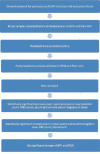Assessment of pre and post donation changes in hematological parameters and serum calcium and magnesium levels in plateletpheresis donors
- PMID: 35516708
- PMCID: PMC9067219
- DOI: 10.4103/jfmpc.jfmpc_1409_21
Assessment of pre and post donation changes in hematological parameters and serum calcium and magnesium levels in plateletpheresis donors
Abstract
Background: Single donor platelet products are preferred over random donor platelet products due to several advantages. However, safety issues with regard to post procedure hematological decrements and serum calcium and magnesium levels in donors undergoing plateletpheresis have been explored minimally.
Aims: This prospective study was done to analyze the effects of plateletpheresis on donor's hematological parameters and serum calcium and magnesium levels.
Settings and design: It is a prospective, cross-sectional study conducted in the department of immunohematology and blood transfusion.
Material and methods: This study was undertaken on 150 healthy plateletpheresis donors over a period of 1 year. Blood samples were collected from each donor before and after the procedure, one in ethylenediaminetetraacetic acid (EDTA) vial for estimation of hematological parameters and another in plain vial for serum calcium and magnesium levels.
Statistical analysis used: Paired t-test was used to analyze the data.
Results: This study included donors in the age group of 18 to 60 years who underwent plateletpheresis on Haemonetics model of a machine (MCS) + intermittent flow cell separator. A statistically significant increase was observed in mean post procedural Hb (0.95%), Hct (0.7%), and red blood cell (RBC) count (1.3%). There was a decrease in mean post procedural platelet count (27.5%), white blood cell (WBC) count (4.02%), mean serum calcium (1.5%), and serum magnesium (5.1%), which was statistically highly significant (P < 0.001). No significant change was observed in post procedural mean platelet volume (MPV) and platelet distribution width (PDW).
Conclusion: Amid the need of increased demand for plateletpheresis, donor safety must be ensured. Failing to do so can be detrimental to blood supply chain, hence stringent programs for post donation screening of plateletpheresis donors need to be established.
Keywords: Cell separators; hematological parameters; plateletpheresis; serum calcium and magnesium.
Copyright: © 2022 Journal of Family Medicine and Primary Care.
Conflict of interest statement
There are no conflicts of interest.
Figures
Similar articles
-
Impact of Plateletpheresis on the Hemoglobin, Hematocrit, and Total Red Blood Cell Count: An Updated Meta-Analysis.Cureus. 2024 Jun 1;16(6):e61510. doi: 10.7759/cureus.61510. eCollection 2024 Jun. Cureus. 2024. PMID: 38962593 Free PMC article. Review.
-
Pre- and post- donation haematological values in healthy donors undergoing plateletpheresis with five different systems.Blood Transfus. 2009 Jul;7(3):188-92. doi: 10.2450/2009.0064-08. Blood Transfus. 2009. PMID: 19657482 Free PMC article.
-
Comparative evaluation of hematological parameters and instrument performance in single and double plateletpheresis procedures using Haemonetics MCS+ and Trima Accel systems.Transfus Clin Biol. 2025 Feb;32(1):28-38. doi: 10.1016/j.tracli.2024.11.002. Epub 2024 Nov 13. Transfus Clin Biol. 2025. PMID: 39542083
-
Frequency of adverse events in plateletpheresis donors in regional transfusion centre in North India.Transfus Apher Sci. 2013 Oct;49(2):244-8. doi: 10.1016/j.transci.2013.06.003. Epub 2013 Jul 3. Transfus Apher Sci. 2013. PMID: 23830186
-
Effect of plateletpheresis on hematocrit, hemoglobin and erythrocyte count: Meta-analysis 1980-2018.Sci Rep. 2019 Dec 24;9(1):19770. doi: 10.1038/s41598-019-56175-7. Sci Rep. 2019. PMID: 31875045 Free PMC article.
Cited by
-
Impact of Plateletpheresis on the Hemoglobin, Hematocrit, and Total Red Blood Cell Count: An Updated Meta-Analysis.Cureus. 2024 Jun 1;16(6):e61510. doi: 10.7759/cureus.61510. eCollection 2024 Jun. Cureus. 2024. PMID: 38962593 Free PMC article. Review.
-
Hematological Changes in Platelet Apheresis Donors: An Observational Study.Cureus. 2024 Nov 18;16(11):e73907. doi: 10.7759/cureus.73907. eCollection 2024 Nov. Cureus. 2024. PMID: 39697965 Free PMC article.
References
-
- Freireich EJ. Origins of platelet transfusion therapy. Transfuse Med Rev. 2011;25:252–6. - PubMed
-
- Ness PM, Lee C, Sally A. Single donor versus pooled random donor platelet concentrates. Transfusion. 2001;8:392–96. - PubMed
-
- Gite V, Dhakane M. Analysis of pre and post donation haematological values in plateletpheresis donors. Apollo Med. 2015;12:123–5. - PubMed
-
- Glicher RO, Smith JW. Apheresis principles and technology of Hemapheresis. In: Simon TL, Synder EL, Solheim BG, Stowell CP, Strauss RG, Petrides M, editors. Rossi's Principles of Transfusion Medicine. 4th ed. Wiley Blackwell; 2009. p. 624.
-
- Hartwell BA, Eastvold PJ. Apheresis. In: Harmening DM, editor. Modern Blood Banking and Transfusion Practices. 6th ed. New Delhi: Jaypee Brothers Medical publishers; 2012. pp. 346–7.
LinkOut - more resources
Full Text Sources


